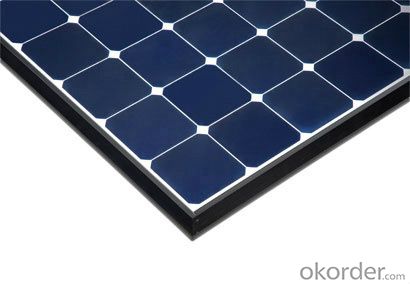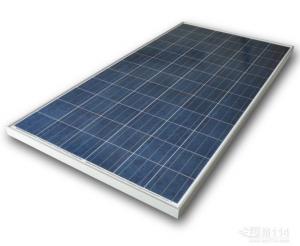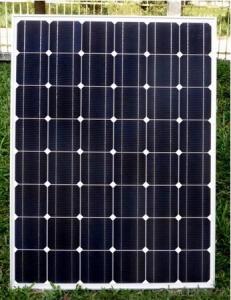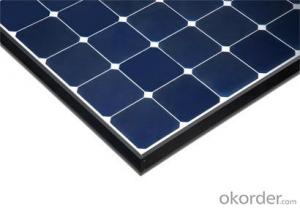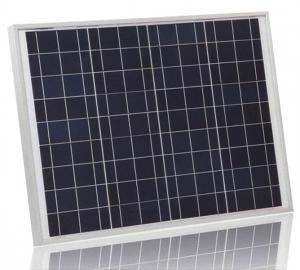Riverside Solar Panels - Mono Solar Panel 100w A Grade with Cheapest Price
- Loading Port:
- Tianjin
- Payment Terms:
- TT OR LC
- Min Order Qty:
- 100 watt
- Supply Capability:
- 1000 watt/month
OKorder Service Pledge
OKorder Financial Service
You Might Also Like
Specification
Mono Solar Panel 100W A Grade with Cheapest Price
product description
Solar energy is radiant light and heat from the Sun harnessed using a range of ever-evolving technologies such assolar heating, photovoltaics, solar thermal energy, solar architecture and artificial photosynthesis.[1][2]
It is an important source of renewable energy and its technologies are broadly characterized as either passive solar oractive solar depending on the way they capture and distribute solar energy or convert it into solar power. Active solar techniques include the use of photovoltaic systems, concentrated solar power and solar water heating to harness the energy. Passive solar techniques include orienting a building to the Sun, selecting materials with favorable thermal mass or light dispersing properties, and
Each module is rated by its DC output power under standard test conditions, and typically ranges from 100 to 365 watts. The efficiency of a module determines the area of a module given the same rated output – an 8% efficient 230 watt module will have twice the area of a 16% efficient 230 watt module. There are a few solar panels available that are exceeding 19% efficiency. A single solar module can produce only a limited amount of power; most installations contain multiple modules. A photovoltaic system typically includes a panel or an array of solar modules, a solar inverter, and sometimes a battery and/or solar tracker and interconnection wiring.

Feature
The modules use high-quality imported polycrystalline or Polycrystalline solar panel;
Enclosed by high-rigidity tempered glass, with excellent light transmittance and output performance;
Surface treated with reflection-reducing process, increasing the light absorption.
Back sealed with anti-aging EVA, resistant from moisture and corrosion.
The efficiency of our Polycrystalline solar cell is over 17%, and polycrystalline panel is over 16%. We stipulate, the allowance of each panel’s rated power has to be positive. Each panel is strictly tested before leaving the factory.
Our solar panel is designed with a lifetime of 25 years, and guaranteed that the power decline less than 10% within 10 years, and 20% within 20 years.
Packaging
28pcs into one box 48pcs into one pallet.
Delivery
20 days after received full payment
Payment term
LC&TT
- Q: Solar panel experiment ?wat are some experiments with solar panels that has not yet been proven? ideas
- Acciona of Spain is actively conducting research in all sorts of alternative energy. I understand they have an experimental solar farm someplace in the desert southwest of the U.S. that is made up of 283,000 panels. I don't know the size of the panels or anything else about the project other than that. 50 years ago it would have been the U.S. conducting leading research in solar energy-especially in the U.S. Southwest.
- Q: Hi All,I need some resources for a research project i'm doing on Solar Panels/Cells.So do you know of any good books or online materials that basically covers how solar cellwork from level 0 to calculating the energy output based on intensity of the light and the area of the panel. Book titles will be preferable but i'd like to build a strong base before tackling long and complicated formula(s)... so any suggestions? Your help will be appreciated :)THANKS IN ADVANCE!!
- How Solar Cells Work by Scott Aldous Inside This Article . Introduction to How Solar Cells Work 2. Photovoltaic Cells: Converting Photons to Electrons 3. How Silicon Makes a Solar Cell 4. Anatomy of a Solar Cell 5. Energy Loss in a Solar Cell 6. Solar-powering a House 7. Solving Solar-power Issues 8. Solar-power Pros and Cons 9. Lots More Information 0. See all Physical Science articles You've probably seen calculators that have solar cells -- calculators that never need batteries, and in some cases don't even have an off button. As long as you have enough light, they seem to work forever. You may have seen larger solar panels -- on emergency road signs or call boxes, on buoys, even in parking lots to power lights. Although these larger panels aren't as common as solar powered calculators, they're out there, and not that hard to spot if you know where to look. There are solar cell arrays on satellites, where they are used to power the electrical systems. You have probably also been hearing about the solar revolution for the last 20 years -- the idea that one day we will all use free electricity from the sun. This is a seductive promise: On a bright, sunny day, the sun shines approximately ,000 watts of energy per square meter of the planet's surface, and if we could collect all of that energy we could easily power our homes and offices for free.
- Q: I had someone quote me for solar panels on my house but I can't afford it. They were talking about how I have enough room and the perfect location to put many of them and actually get paid for it. I have about a half acre that is tiered and points in the correct direction for them to get pretty much the full day sun. Additionally, I live in so cal where it is sunny most of the year. Does anyone know if solar companies will lease or install them to get the payback? I would be happy to allow them to use the land just to cover my electrical expense and they could have any payback.
- Hi, In the UK solar companies will fit them for nothing. The company gets the government allowance (called feed in tarrif FIT) and you get the benefit of the reduction in your power bills. The solar company make better money than the householder,BUT if the householder is in most of the day it could be most beneficial if the energy is used while the panels are generating, this means the householder is not paying for the power from the grid. If the householder works normally from 9 to 5 then there is less advantage in terms of getting free power from the panels. Best Wishes.
- Q: Can solar panels power an entire home?
- Yes, solar panels can power an entire home. By harnessing the energy from the sun, solar panels can generate electricity to meet the energy needs of a household. The number of solar panels required depends on factors such as the home's energy consumption, sun exposure, and panel efficiency. With proper installation and sizing, solar panels can effectively provide power for all the electrical needs of a home, including lighting, appliances, and heating/cooling systems.
- Q: Can solar panels power my entire home?
- Yes, solar panels have the potential to power your entire home, depending on various factors such as the size of your solar panel system, the amount of sunlight in your area, your energy consumption patterns, and the efficiency of your appliances. It is important to consult with a solar professional to assess your specific energy needs and design a system that can meet your requirements.
- Q: How do I clean my solar panels?
- To clean your solar panels, start by checking the manufacturer's instructions as some panels may have specific cleaning requirements. Generally, you can clean them by gently rinsing with water using a hose or a bucket and sponge. Avoid using abrasive materials or harsh chemicals that could damage the panels. If there's stubborn dirt or debris, you can use a mild soap solution with a soft brush to gently scrub the surface. Regularly cleaning your solar panels will help to maintain their efficiency and ensure optimal energy production.
- Q: Can solar panels be installed on a residential community?
- Yes, solar panels can be installed on a residential community. Many homeowners and community associations are choosing to install solar panels on rooftops or in shared spaces to generate clean, renewable energy for their homes and reduce their reliance on grid-supplied electricity.
- Q: Can solar panels be used in areas with limited access to electricity?
- Yes, solar panels can be used in areas with limited access to electricity. This is because solar panels generate electricity using sunlight, so as long as there is sunlight available, they can generate power. In fact, solar panels are often used as a sustainable and reliable source of electricity in remote or off-grid locations where traditional power infrastructure is not available or feasible.
- Q: Can solar panels be installed on a warehouse or storage facility?
- Yes, solar panels can be installed on a warehouse or storage facility. In fact, these types of buildings often have large, flat rooftops that are ideal for solar panel installation. Installing solar panels on warehouses or storage facilities can help generate clean and renewable energy, reduce electricity costs, and contribute to sustainability efforts.
- Q: Can solar panels be installed on tall buildings?
- Yes, solar panels can be installed on tall buildings. In fact, tall buildings often provide an ideal location for solar panel installation due to their unobstructed access to sunlight and reduced shading from surrounding structures. Installing solar panels on tall buildings allows for efficient utilization of available roof space and maximizes the potential for generating renewable energy.
Send your message to us
Riverside Solar Panels - Mono Solar Panel 100w A Grade with Cheapest Price
- Loading Port:
- Tianjin
- Payment Terms:
- TT OR LC
- Min Order Qty:
- 100 watt
- Supply Capability:
- 1000 watt/month
OKorder Service Pledge
OKorder Financial Service
Similar products
Hot products
Hot Searches
Related keywords


